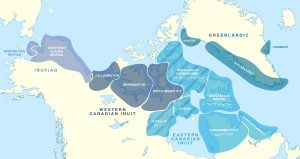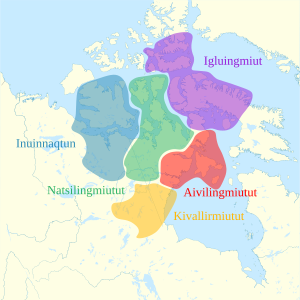Inuvialuktun facts for kids
Quick facts for kids Inuvialuktun |
||||
|---|---|---|---|---|
| Native to | Canada | |||
| Region | Northwest Territories, Nunavut | |||
| Ethnicity | 3,110 Inuvialuit | |||
| Native speakers | 680, 22% of ethnic population (2016 census) | |||
| Language family |
Eskimo–Aleut
|
|||
| Dialects |
Siglitun (Sallirmiutun)
|
|||
| Writing system | Latin script, Syllabics | |||
| Official status | ||||
| Official language in | Northwest Territories, Nunavut | |||
| Regulated by | Inuvialuit Cultural Centre and Inuit Tapiriit Kanatami | |||
|
||||
Inuvialuktun is a group of Inuit languages. People called the Inuvialuit speak it. They live in the northern Northwest Territories in Canada. Some parts of this language are also spoken in Nunavut. It is part of what is known as Western Canadian Inuit.
Contents
Where Inuvialuktun is Spoken
Inuvialuktun is spoken by the Inuit people. They live near the Mackenzie River delta. They also live on Banks Island and parts of Victoria Island. You can hear it along the Arctic Ocean coast of the Northwest Territories. These areas are known as the Inuvialuit Settlement Region.
Inuvialuktun is not just one language. It is a group of three different ways of speaking. These include Sallirmiutun, which is sometimes called Inuvialuktun proper. There is also the Kangiryuarmiutun dialect of Inuinnaqtun. This is spoken on Victoria Island in the east. Finally, there is the Uummarmiutun dialect of Iñupiaq. This is spoken around Inuvik and Aklavik in the west.
Inuvialuktun, Inuinnaqtun, and Inuktitut are three of the eleven official languages. These are used in the Northwest Territories. Inuinnaqtun is also an official language in Nunavut, along with Inuktitut.
The Future of Inuvialuktun
The different ways of speaking Inuvialuktun are in danger. Fewer and fewer people are using them. English has become the main language in these communities.
Studies show that not many people speak Inuktitut in the Northwest Territories. In 2016, Statistics Canada reported that 680 people spoke some form of Inuktitut. This is about 22% of the 3,110 Inuvialuit people. Only 550 people (18%) use it at home.
Many non-Inuit people live in Inuvialuit areas. Also, there isn't one common dialect among the speakers. This makes the future of the Inuit language in the Northwest Territories quite challenging.
History of the Language
Before the 1900s, the Inuvialuit Settlement Region was home to the Siglit Inuit. They spoke a language called Siglitun. However, their numbers greatly decreased in the late 1800s. This was due to new diseases.
In the 1910s and 1920s, Inuit people from Alaska moved into these areas. They were looking for furs because the Hudson's Bay Company wanted them. These new Inuit are called Uummarmiut. This name means people of the green trees. It refers to their homes near the edge of the forest.
At first, the Siglit and Uummarmiut did not get along. But over time, these differences have disappeared. Today, the two groups live together and are well mixed.
How Inuvialuktun Sounds
The sounds of Inuvialuktun are similar to other Inuit languages. Most Inuit languages have fifteen consonant sounds. They also have three vowel sounds. Each vowel can be long or short.
Some Inuit languages, like Inupiatun, have special sounds called retroflexes. However, these sounds have disappeared from most Canadian and Greenlandic dialects.
How Inuvialuktun is Written
Inuvialuktun and Inuinnaqtun are written using the Latin alphabet. This is the same alphabet English uses. They do not traditionally use Canadian Aboriginal syllabics. However, some dialects spoken in Nunavut, to the east, do use syllabics.
Different Dialects of Inuvialuktun
As mentioned, the Inuvialuktun dialects are in danger. English has become the main language. The Inuvialuit Cultural Resource Centre says only 10% of the 4,000 Inuvialuit speak any form of Inuktitut. Only 4% use it at home.
The 2001 Statistics Canada report was slightly better. It said 765 people identified as Inuktitut speakers. This was out of 3,905 Inuvialuit people. The future of the Inuit language in the NWT looks difficult. This is because many non-Inuit live there. Also, there is no single common dialect among the few remaining speakers.
Here are some of the dialects, from east to west:
- Iglulingmiut or North Baffin: Spoken on western Baffin Island.
- Aivilingmiutut or Aivilik: Spoken on the northern Hudson Bay shore of the Kivalliq Region.
- Kivallirmiutut or Kivalliq or Caribou: Spoken on the southern Hudson Bay shore of the Kivalliq Region.
- Natsilingmiutut or Netsilik: Has three subdialects: Natsilik proper, Arviligjuaq, and Utkuhiksalik.
- Inuinnaqtun: Has four subdialects: Kangiryuarmiutun, Kugluktuk, Bathurst, and Cambridge. The Kangiryuarmiutun subdialect is spoken in Ulukhaktok. It is very similar to Natsilingmiutut.
- Siglitun: People thought this dialect was gone by the 1980s. But it is still spoken by people in Paulatuk, Sachs Harbour, and Tuktoyaktuk.
The Inuvialuk dialects in Nunavut are often counted as Inuktitut. These include Iglulingmiut, Aivilingmiutut, Kivallirmiutut, and eastern Natsilingmiutut. The government of the NWT only officially recognizes Inuinnaqtun and Inuvialuktun.
Also, Uummarmiutun is the dialect of the Uummarmiut. It is almost the same as the Inupiatun dialect spoken in Alaska. So, it is seen as an Inupiat language. But it is usually grouped with Inuvialuktun. This is because it is spoken in the Inuvialuit Settlement Region of the NWT. You can find Uummarmiutun in Inuvik and Aklavik.
Useful Phrases in Inuvialuktun
| English | Inuvialuktun | pronunciation |
|---|---|---|
| Hello | Atitu | /atitu/ |
| Good Bye | Ilaannilu/Qakugulu | /ilaːnːilu/ / /qakuɡulu/ |
| Thank you | Quyanainni | /qujanainːi/ |
| You are welcome | Amiunniin | /amiunːiːn/ |
| How are you? | Qanuq itpin? | /qanuq itpin/ |
| I am fine | Nakuyumi/Nakuyumi assi | /nakujumi asːi/ |
| Good morning | Ublaami | /ublaːmi/ |
| Yes | Ii | /iː/ |
| No | Naaggai | /naːɡːai/ |
| It's cold! Brrr! | Alaappa! | /alaːpːa/ |
| *Gasp* (an expression used when alarmed or fearful) |
Alii | /aliː/ |
| See you later | Anaqanaallu | /anaqanaːlːu/ |
| Wow/Awesome | Aqqali | /aqːali/ |
| Listen! | Ata! | /ata/ |
| See you, too | Ilaanniptauq | /ilaːnːiptauq/ |
| It is like this | Imaaniittuaq | /imaːniːtːuaq/ |
| Like this | Imanna | /imanːa/ |
| Whose? | Kia? | /kia/ |
| Who is this? | Kina una? | /kina una/ |
| Where? | Nani?/Naung?/Sumi? | /nani/ / /nauŋ/ / /sumi/ |
| Where are you from? | Nakinngaaqpin?/Sumiutauvin? | /nakiŋːaːqpin/ / /sumiutauvin/} |
| How much does it cost? | Qanuq akitutigivaa? | /qanuq akitutiɡivaː/ |
| How old is he/she? | Qanuq ukiuqtutigiva? | /qanuq ukiututiɡiva/ |
| What do you call it? | Qanuq taivakpiung? | /qanuq taivakpiuŋ/ |
| What is the time? | Sumukpaung? | /sumukpauŋ/ |
| What for? | Suksaq? | /suksaq/ |
| Why? Or how come? | Suuq? | /suːq/ |
| What? | Suva?/Suna? | /suva/~/suna/ |
| Doesn't matter/It is ok | Sunngittuq | /suŋːitːuq/ |
| What are you doing? | Suvin? | /suvin/ |
| It can't be helped! Too bad. | Qanurviituq! | /qanuʁviːtuq/ |
| in fact, actually | Nutim | [nutim] |
| Do it again! | Pipsaarung! | [pipsaːʁuŋ] |
| Go ahead and do it | Piung | [piuŋ] |
| It is cold out! | Qiqauniqtuaq | /qiqauniqtuaq/ |
| Christmas | Qitchirvik | /qittʃiʁviq/ |
| Candy | Uqummiaqataaq | [/uqumːiaqataːq/ |
| Play music | Atuqtuuyaqtuaq | /atuqtuːjaqtuaq/ |
| Drum dancing | Qilaun/Qilausiyaqtuaq | /qilaun/ / /qilausijaqtuaq/ |
| Church | Angaadjuvik | /aŋaːdʒuvik/ |
| Bell | Aviluraun | /aviluʁaun/ |
| Jewels | Savaqutit | /savaqutit/ |
| Eskimo ice cream | Akutuq | /akutaq/ |
| That's all! | Taima! | /taima/ |
Inuvialuktun Words for Snow
The Inuvialuktun language has many words for snow. This shows how important snow is in their lives.
| Siglitun Inuvialuktun snow terms | English meaning |
|---|---|
| Apiqaun | The first layer of snow in autumn that stays. |
| Apusiqqaun | The very first snowfall. |
| Aqiuyaq | A small, fresh pile of snow made by the wind. |
| Masak | Snow that is full of water. |
| Mauyaa | Snow that is deep and soft. |
| Minguliruqtuaq | Wet snow that is blowing in the wind. |
| Piangnaq | Good snow conditions for traveling by sled. |
See also
 In Spanish: Idioma inuvialuktun para niños
In Spanish: Idioma inuvialuktun para niños



